|
|
Post by LuisV on Apr 8, 2021 9:45:10 GMT -5
I had 45mins this morning, so I added the Node 2i to the Roon group, so I can compare it's internal DAC to the Ares and Bifrost:  Dimensionally, the Node 2i's DAC is flat... soundfield is more inline with the speaker's plane. The soundstage isn't as wide, tall nor deep. You lose details and refinement, for example, the shimmer to high-hats, cymbals, etc. is less defined, not as crisp... it doesn't sound bad, it just has less definition. Bass is deep, but not as articulate as the external DACs, because of this, it sounds dull in comparison to the external DACs. To be honest, tonally, the Node 2i's DAC sounds closer to the Ares in NOS mode; however, the Ares is more refined and resolves more detail over the Node's DAC. |
|
|
|
Post by chops on Apr 8, 2021 10:33:38 GMT -5
Yeah, the Node DAC is somewhat blah and lifeless.
|
|
KeithL
Administrator   
Posts: 10,273
|
Post by KeithL on Apr 8, 2021 13:46:52 GMT -5
There are a lot of distinctions involved when it comes to filters.... and I don't know the details of theirs. HOWEVER.... If you play a file recorded at a sample rate of 44k through a NOS (non-oversampling) DAC... Then, since you are not applying oversampling, the data is actually being presented to the DAC itself at a sample rate of 44k. This means that, after conversion, you MUST apply a filter that effectively removes all frequencies above 22k (the Nyquist frequency). (If you don't the resulting "images" and "artifacts" will generate some really nasty distortions... )
One choice you will have is to keep reasonably flat response out to 20 kHz by applying a VERY FAST filter that cuts off right at 20 kHz.... (But such filters are difficult to design, require expensive components, and tend to have nasty consequences in terms of things like phase response.)
(And, even if you're willing to accept the costs, the other tradeoffs involved aren't nice at all.) The other choice is to use a SLOW ROLL OFF filter that offers reasonably good attenuation at 20 kHz and above. But, in order to achieve that, you're going to have to start rolling off the high end at a much lower frequency. (Slow roll off is another way of saying gradual - so, in order to be well down at 22 kHz, you're going to have to start rolling off lower.)
So now you have audible high-end roll off. (But you may have less ringing in return.) The Catch-22 there is that it's hard to tell whether you're hearing less ringing... or just less high end due to the high-end roll off.
These tradeoffs are why OVERSAMPLING was invented in the first place... (because it avoids them).
In order to figure out what else is going on you would have to see the actual curves and other characteristics of their filters... I VERY much doubt you're going to hear roll off at either 37 kHz or 65 kHz.... So the only question there is how their response varies inside the audible range in order to make them sound audibly different.... If they do in fact sound audibly different...
They may well sound audibly different... due to different impulse or phase characteristics... or different response below 20 kHz or so....
(Different filters, with slightly different characteristics, do in fact sound different... it's just not always obvious whether "different" means "better".)
You might want to check the specifications on the Ares for a bit of insight. In general NOS (non-oversampling) DACs, especially when using "slow rolloff filters", tend to roll off the high end... When playing 44k sample rate files, in a NOS DAC, a slow filter MUST start rolling off high frequencies inside the audible range.
This tends to de-emphasize the very high frequencies... which makes them sound "smoother and mellower"...
But, technically, it is merely acting like a tone control and "turning the treble down a tiny bit".
(And many people seem to prefer to interpret this as something far more mystical in nature...  ) Please note that I'm not suggesting that you purchase a product based on specifications rather than what you hear. However there are often distinct penalties to not looking at that sort of details. I've actually seen people pay hundreds of dollars for "special cables that sounded mellow".
When they could have achieved the exact same result in sound by adding a fifty cent capacitor someplace else instead. Or using a tone control to simply adjust the sound the way they want it. (Yet some audiophiles would rather pay $500 for a cable than be seen turning a tone control.)
Thanks for that KeithL, Is that what these filters are? For DSD, PCM, etc?  |
|
Deleted
Deleted Member
Posts: 0
|
Post by Deleted on Apr 8, 2021 15:53:53 GMT -5
There are a lot of distinctions involved when it comes to filters.... and I don't know the details of theirs. HOWEVER.... If you play a file recorded at a sample rate of 44k through a NOS (non-oversampling) DAC... Then, since you are not applying oversampling, the data is actually being presented to the DAC itself at a sample rate of 44k. This means that, after conversion, you MUST apply a filter that effectively removes all frequencies above 22k (the Nyquist frequency). (If you don't the resulting "images" and "artifacts" will generate some really nasty distortions... )
One choice you will have is to keep reasonably flat response out to 20 kHz by applying a VERY FAST filter that cuts off right at 20 kHz.... (But such filters are difficult to design, require expensive components, and tend to have nasty consequences in terms of things like phase response.)
(And, even if you're willing to accept the costs, the other tradeoffs involved aren't nice at all.) The other choice is to use a SLOW ROLL OFF filter that offers reasonably good attenuation at 20 kHz and above. But, in order to achieve that, you're going to have to start rolling off the high end at a much lower frequency. (Slow roll off is another way of saying gradual - so, in order to be well down at 22 kHz, you're going to have to start rolling off lower.)
So now you have audible high-end roll off. (But you may have less ringing in return.) The Catch-22 there is that it's hard to tell whether you're hearing less ringing... or just less high end due to the high-end roll off.
These tradeoffs are why OVERSAMPLING was invented in the first place... (because it avoids them).
In order to figure out what else is going on you would have to see the actual curves and other characteristics of their filters... I VERY much doubt you're going to hear roll off at either 37 kHz or 65 kHz.... So the only question there is how their response varies inside the audible range in order to make them sound audibly different.... If they do in fact sound audibly different...
They may well sound audibly different... due to different impulse or phase characteristics... or different response below 20 kHz or so....
(Different filters, with slightly different characteristics, do in fact sound different... it's just not always obvious whether "different" means "better".)
Thanks for that KeithL, Is that what these filters are? For DSD, PCM, etc?  Thank you very much for your comprehensive response Keith. I've never experimented w/ these sort of filters. As is now I'm listening to the slow filter which I really love. I mean I doubt there was a ringing because my Ulfberhts utilize Beryllium high frequency tweeters. The excitement from the sharp and slow filters are quite noticeable. Where I could hear the high hats sizzle or sparkle before they are not so overly exaggerated w/ the slow filter. And lastly, I just wished to confirm that I am having trouble articulating the difference between the narrow 37khz and wide 65khz filters.... but if forced to struggle w/ an articulation I'd say that the 65khz sounds more "live". I am really enjoying for the first time the imaging of the soundstage. I mean having no center channel now really has me shaking my head by such a phantom center.. . This has been a fun journey despite the expenses! Enjoy gent, William |
|
KeithL
Administrator   
Posts: 10,273
|
Post by KeithL on Apr 8, 2021 16:51:29 GMT -5
Just FYI..... in the general context "ringing" refers to a relatively specific form of energy storage.
When you hit a bell with a hammer the hammer imparts a single jolt of energy to the bell over a short period of time. And, without ringing, all you would hear would be a single sharp click.
But, because of the springiness of the metal, the bell bends as the hammer hits it, then springs back... And some of the energy involved ricochets around for quite some time...
The result of this is that the bell stores some of the energy from the hammer and releases it slowly... And the result is the sound we recognize as "the bell ringing". (Bass drums ring too... but at a much lower frequency.)
In point of fact virtually all speaker drivers do this to a degree... Once you start the dome or cone moving, it doesn't want to stop, so some of the energy continues to ricochet around for a while.
And beryllium dome tweeters are known for it... although some do it far more than others... This isn't as bad as it sounds because often the ringing only occurs for a small fraction of a second... And, quite often with tweeters, it occurs at ultrasonic frequencies that you can't hear anyway. But, because it tends to "smear out the sound" slightly in time, often in slightly different ways, it does contribute to how a particular speaker sounds.
In the context of DACs what we're referring to is electrical ringing.
In order to convert digital audio back into analog audio a DAC MUST apply filtering to the signal. This is necessary, and unavoidable, and the signal WILL NOT be correct unless this filtering is applied. However all filters introduce at least a tiny bit of ringing.... This ringing causes the signal to be spread slightly in time... Furthermore different filters create different amounts of ringing and at different points in time... As it turns out, filters with sharper frequency cutoff slopes tend to produce more ringing (it lasts longer).
And filters with gentler frequency cutoff slopes tend to produce less ringing (at the cost of less accurate frequency response). And filters with sharp slopes and shorter ringing tend to produce a less even frequency response and more phase shift around cutoff.
And, depending on the design of the filter, the ringing can be shifted in time to before or after the event that precipitates it.
When we talk about "impulse response" in a DAC, we talk about "the way it rings" (how much and when). For example, you may have "a sharp filter, with short symmetrical ringing"...
And you may have "a slow roll off filter, with very little pre-ringing, but a lot of post ringing"...
Or you may have "a slow roll off filter, with very short symmetrical ringing"...
One popular DAC chip, the Wolfson 8741, offered a choice of 21 different filter options... Each with a different combination of ringing and frequency response characteristics... With that chip most of the choices are "pretty darned close to perfect" - but some still have subtle audible differences.
And not everyone agrees which characteristics are the most important and which sacrifices are "worth it".
In the context of our discussion many people prefer the sound of "a slow roll off filter with only post-ringing" and find it to sound "more natural"...
Even though, in terms of frequency response, it is less accurate than "a sharp filter with short symmetrical ringing" preferred by others. And many prefer a compromise about halfway between those two.
(Those are probably the three most common and most popular choices...)
There are a lot of distinctions involved when it comes to filters.... and I don't know the details of theirs. HOWEVER.... If you play a file recorded at a sample rate of 44k through a NOS (non-oversampling) DAC... Then, since you are not applying oversampling, the data is actually being presented to the DAC itself at a sample rate of 44k. This means that, after conversion, you MUST apply a filter that effectively removes all frequencies above 22k (the Nyquist frequency). (If you don't the resulting "images" and "artifacts" will generate some really nasty distortions... )
One choice you will have is to keep reasonably flat response out to 20 kHz by applying a VERY FAST filter that cuts off right at 20 kHz.... (But such filters are difficult to design, require expensive components, and tend to have nasty consequences in terms of things like phase response.)
(And, even if you're willing to accept the costs, the other tradeoffs involved aren't nice at all.) The other choice is to use a SLOW ROLL OFF filter that offers reasonably good attenuation at 20 kHz and above. But, in order to achieve that, you're going to have to start rolling off the high end at a much lower frequency. (Slow roll off is another way of saying gradual - so, in order to be well down at 22 kHz, you're going to have to start rolling off lower.)
So now you have audible high-end roll off. (But you may have less ringing in return.) The Catch-22 there is that it's hard to tell whether you're hearing less ringing... or just less high end due to the high-end roll off.
These tradeoffs are why OVERSAMPLING was invented in the first place... (because it avoids them).
In order to figure out what else is going on you would have to see the actual curves and other characteristics of their filters... I VERY much doubt you're going to hear roll off at either 37 kHz or 65 kHz.... So the only question there is how their response varies inside the audible range in order to make them sound audibly different.... If they do in fact sound audibly different...
They may well sound audibly different... due to different impulse or phase characteristics... or different response below 20 kHz or so....
(Different filters, with slightly different characteristics, do in fact sound different... it's just not always obvious whether "different" means "better".)
Thank you very much for your comprehensive response Keith. I've never experimented w/ these sort of filters. As is now I'm listening to the slow filter which I really love. I mean I doubt there was a ringing because my Ulfberhts utilize Beryllium high frequency tweeters. The excitement from the sharp and slow filters are quite noticeable. Where I could hear the high hats sizzle or sparkle before they are not so overly exaggerated w/ the slow filter. And lastly, I just wished to confirm that I am having trouble articulating the difference between the narrow 37khz and wide 65khz filters.... but if forced to struggle w/ an articulation I'd say that the 65khz sounds more "live". I am really enjoying for the first time the imaging of the soundstage. I mean having no center channel now really has me shaking my head by such a phantom center.. . This has been a fun journey despite the expenses! Enjoy gent, William |
|
Deleted
Deleted Member
Posts: 0
|
Post by Deleted on Apr 8, 2021 18:44:59 GMT -5
Just FYI..... in the general context "ringing" refers to a relatively specific form of energy storage.
When you hit a bell with a hammer the hammer imparts a single jolt of energy to the bell over a short period of time. And, without ringing, all you would hear would be a single sharp click.
But, because of the springiness of the metal, the bell bends as the hammer hits it, then springs back... And some of the energy involved ricochets around for quite some time...
The result of this is that the bell stores some of the energy from the hammer and releases it slowly... And the result is the sound we recognize as "the bell ringing". (Bass drums ring too... but at a much lower frequency.)
In point of fact virtually all speaker drivers do this to a degree... Once you start the dome or cone moving, it doesn't want to stop, so some of the energy continues to ricochet around for a while.
And beryllium dome tweeters are known for it... although some do it far more than others... This isn't as bad as it sounds because often the ringing only occurs for a small fraction of a second... And, quite often with tweeters, it occurs at ultrasonic frequencies that you can't hear anyway. But, because it tends to "smear out the sound" slightly in time, often in slightly different ways, it does contribute to how a particular speaker sounds.
In the context of DACs what we're referring to is electrical ringing.
In order to convert digital audio back into analog audio a DAC MUST apply filtering to the signal. This is necessary, and unavoidable, and the signal WILL NOT be correct unless this filtering is applied. However all filters introduce at least a tiny bit of ringing.... This ringing causes the signal to be spread slightly in time... Furthermore different filters create different amounts of ringing and at different points in time... As it turns out, filters with sharper frequency cutoff slopes tend to produce more ringing (it lasts longer).
And filters with gentler frequency cutoff slopes tend to produce less ringing (at the cost of less accurate frequency response). And filters with sharp slopes and shorter ringing tend to produce a less even frequency response and more phase shift around cutoff.
And, depending on the design of the filter, the ringing can be shifted in time to before or after the event that precipitates it.
When we talk about "impulse response" in a DAC, we talk about "the way it rings" (how much and when). For example, you may have "a sharp filter, with short symmetrical ringing"...
And you may have "a slow roll off filter, with very little pre-ringing, but a lot of post ringing"...
Or you may have "a slow roll off filter, with very short symmetrical ringing"...
One popular DAC chip, the Wolfson 8741, offered a choice of 21 different filter options... Each with a different combination of ringing and frequency response characteristics... With that chip most of the choices are "pretty darned close to perfect" - but some still have subtle audible differences.
And not everyone agrees which characteristics are the most important and which sacrifices are "worth it".
In the context of our discussion many people prefer the sound of "a slow roll off filter with only post-ringing" and find it to sound "more natural"...
Even though, in terms of frequency response, it is less accurate than "a sharp filter with short symmetrical ringing" preferred by others. And many prefer a compromise about halfway between those two.
(Those are probably the three most common and most popular choices...)
Thank you very much for your comprehensive response Keith. I've never experimented w/ these sort of filters. As is now I'm listening to the slow filter which I really love. I mean I doubt there was a ringing because my Ulfberhts utilize Beryllium high frequency tweeters. The excitement from the sharp and slow filters are quite noticeable. Where I could hear the high hats sizzle or sparkle before they are not so overly exaggerated w/ the slow filter. And lastly, I just wished to confirm that I am having trouble articulating the difference between the narrow 37khz and wide 65khz filters.... but if forced to struggle w/ an articulation I'd say that the 65khz sounds more "live". I am really enjoying for the first time the imaging of the soundstage. I mean having no center channel now really has me shaking my head by such a phantom center.. . This has been a fun journey despite the expenses! Enjoy gent, William Ha, love it - so much I didn't know! |
|
Deleted
Deleted Member
Posts: 0
|
Post by Deleted on Apr 10, 2021 21:25:53 GMT -5
Just an update:
The SMSL M400 has the ability to flip polarity of XLR from pin 2 positive to pin 2 negative. My subwoofers when moved back to the front sound stage were near 180 degrees out of phase. Now the system is capable of 130 decibels [same as the other location I moved the subwoofers to]. I have the front mains utilizing XLR while the active subwoofers are using RCA.
Now I'm wondering whether Dirac Live could even deal w/ 180 degree out phase alignment because the SPL was nowhere near this.
|
|
|
|
Post by LuisV on Apr 12, 2021 15:53:07 GMT -5
Snap, crackle and pop... one of the Psvanes are bad... oh well, at least they looked good...  Back to the GEs and Raytheon / Baldwins...  Replacements received... much better now! Gonna let then bake in for a few days... |
|
|
|
Post by LuisV on Apr 16, 2021 16:32:25 GMT -5
I don't remember if I mentioned it or not, but in a few days I should be getting my brother's S.M.S.L M400 to try out in my system for a while, and do a comparison between it and my Bifrost 2. Just curious... any feedback on the S.M.S.L M400? |
|
|
|
Post by chops on Apr 18, 2021 19:42:22 GMT -5
I don't remember if I mentioned it or not, but in a few days I should be getting my brother's S.M.S.L M400 to try out in my system for a while, and do a comparison between it and my Bifrost 2. Just curious... any feedback on the S.M.S.L M400? Not yet. I'm going to be using it in my headphone rig. Right now, I have another Raspberry Pi4 (with RopieeeXL) up and running, connected to it, but I don't have the headphone amp yet. DHL likes making multiple shipping delays. It was supposed to be here last Friday, and I currently have no idea when it's going to arrive. |
|
|
|
Post by LuisV on Apr 18, 2021 19:50:26 GMT -5
Ha... I hate that crap; FedEx does the same to me; looking forward to reading about your impressions.
|
|
|
|
Post by chops on Apr 20, 2021 7:49:46 GMT -5
A little update... The amp finally showed up last night. Also, a cable that I ordered from Amazon was supposed to arrive yesterday but is showing up today. Other items that I ordered that are supposed to be here today all showed up last night. Anywho, the main rig... 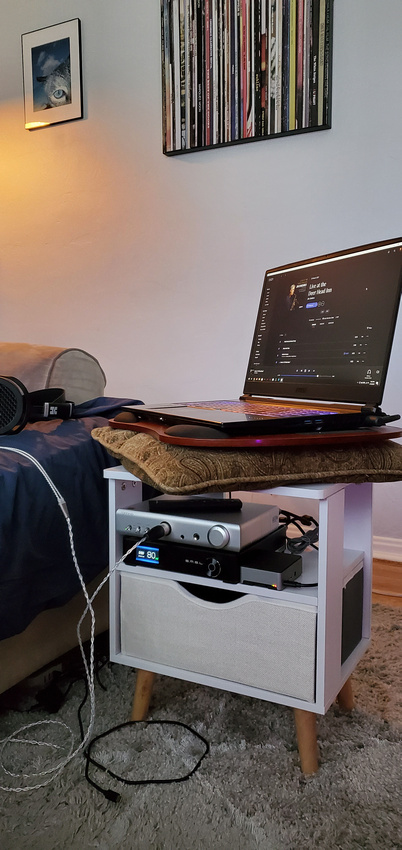 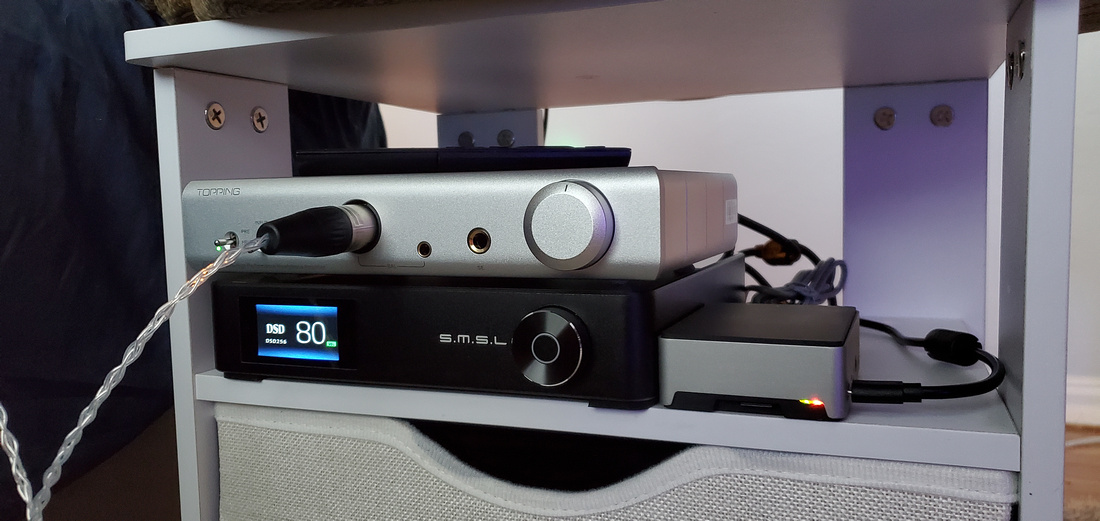  And a simple rig I set up for in the bedroom, mainly for my better half. She'll be using my original MrSpeakers Mad Dog magneplanar headphones... 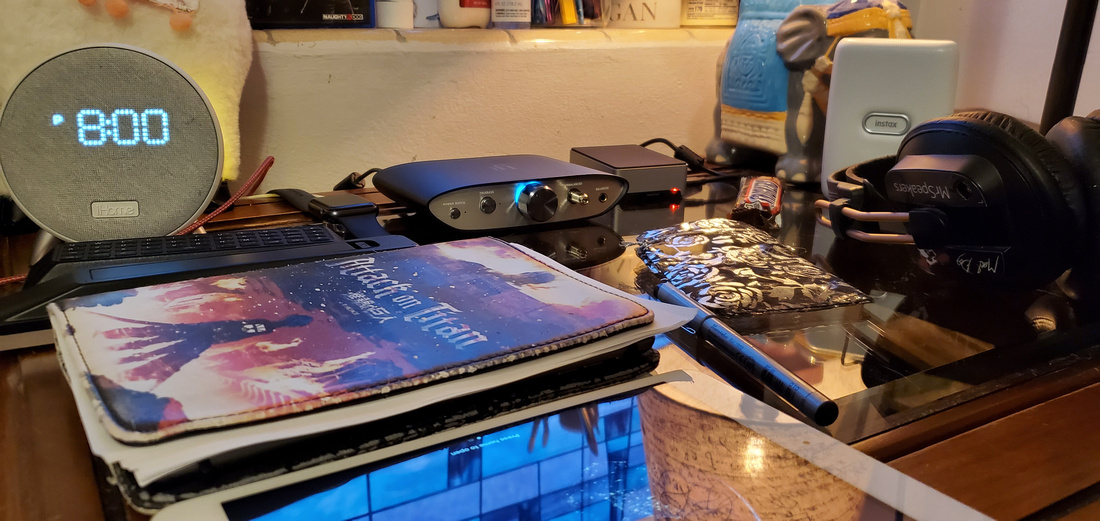 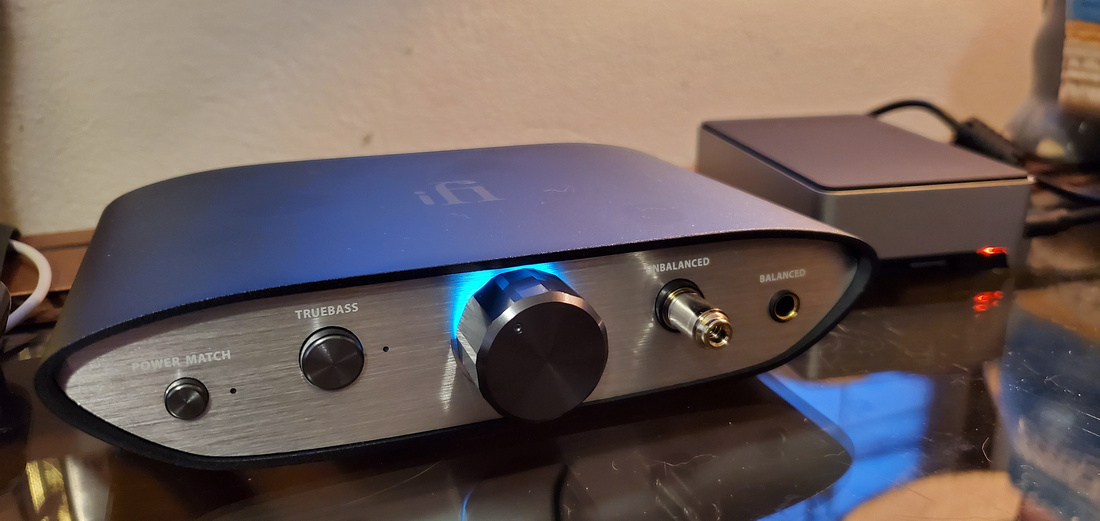 All the goodies that showed up last night... 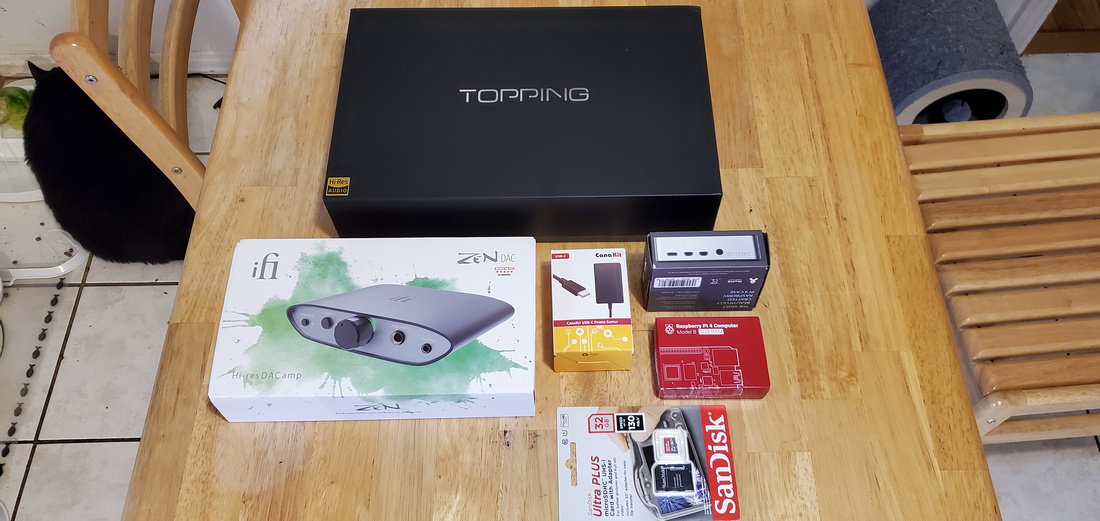 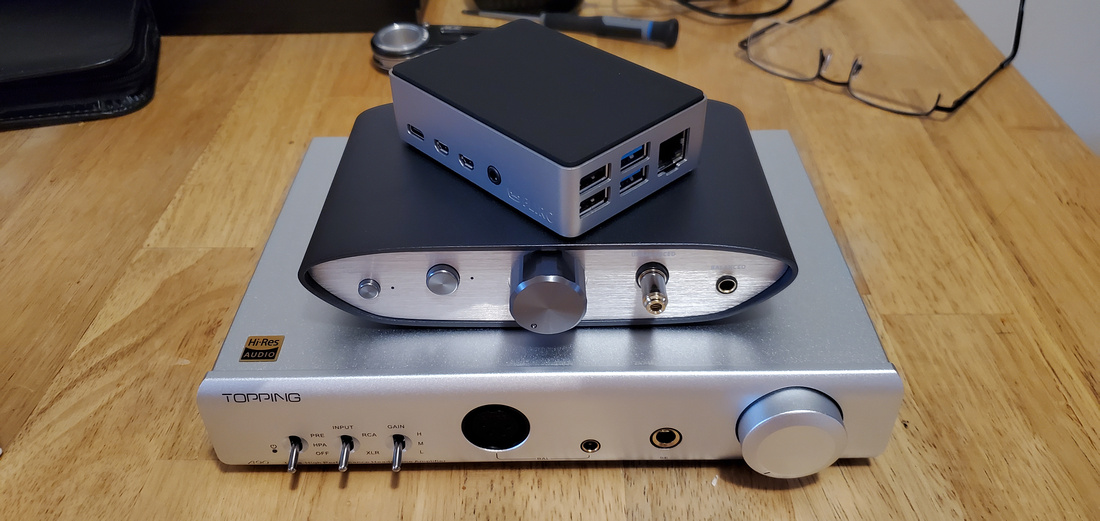 |
|
Deleted
Deleted Member
Posts: 0
|
Post by Deleted on Apr 20, 2021 7:53:51 GMT -5
A little update... The amp finally showed up last night. Also, a cable that I ordered from Amazon was supposed to arrive yesterday but is showing up today. Other items that I ordered that are supposed to be here today all showed up last night. Anywho, the main rig... And a simple rig I set up for in the bedroom, mainly for my better half. She'll be using my original MrSpeakers Mad Dog magneplanar headphones... All the goodies that showed up last night... What cable are you waiting for? Reason I ask is because Toslink input for the SMSL measured lesser than Coax but I see you have a USB connected. Was just curious whether you'll be connecting some kinda streamer too other than a laptop? How are you playing or providing media? Qobuz, Tidal.... etc? |
|
|
|
Post by LuisV on Apr 20, 2021 8:00:37 GMT -5
Nice setups! So... how does the M400 sound? I have a similar gray USB cable, I think it came with a HP printer. lol. What XLRs are those? They look like Y adapters...
|
|
|
|
Post by chops on Apr 20, 2021 8:49:51 GMT -5
A little update... The amp finally showed up last night. Also, a cable that I ordered from Amazon was supposed to arrive yesterday but is showing up today. Other items that I ordered that are supposed to be here today all showed up last night. Anywho, the main rig... And a simple rig I set up for in the bedroom, mainly for my better half. She'll be using my original MrSpeakers Mad Dog magneplanar headphones... All the goodies that showed up last night... What cable are you waiting for? Reason I ask is because Toslink input for the SMSL measured lesser than Coax but I see you have a USB connected. Was just curious whether you'll be connecting some kinda streamer too other than a laptop? How are you playing or providing media? Qobuz, Tidal.... etc? I'm waiting on a couple of headphone cables. One for the Mad Dog's and a really nice Hart Audio balanced cable for the Sundara's. As for connections, I'm not using Toslink or coax. I'm using USB only on all of my DAC's (Bifrost 2, M400, Zen DAC), and they are all getting their signal via three identical Raspberry Pi4's running RoPieeeXL. Music is coming from Roon Core running both Qobuz and Tidal. And because I use RoPieeeXL on all three Pi4's, I can "cast" Spotify to any one of them if I like, which I do on occasion, but not very often. The laptop is just my laptop for controlling Roon Core on the main PC in the other room, and for general everyday stuff. It's not connected to any DAC's. |
|
|
|
Post by chops on Apr 27, 2021 11:32:36 GMT -5
Well, I decided to swap out DAC's today. 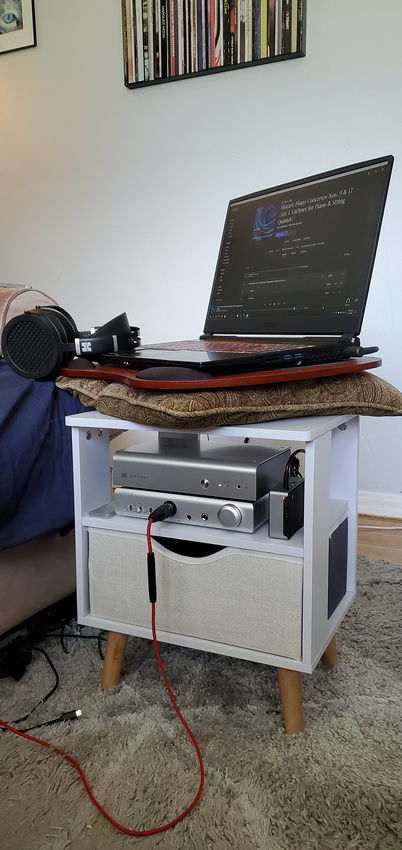 And no, those are NOT scratches or marks on the Bifrost 2. That's just the way the light is hitting the grain in the aluminum... 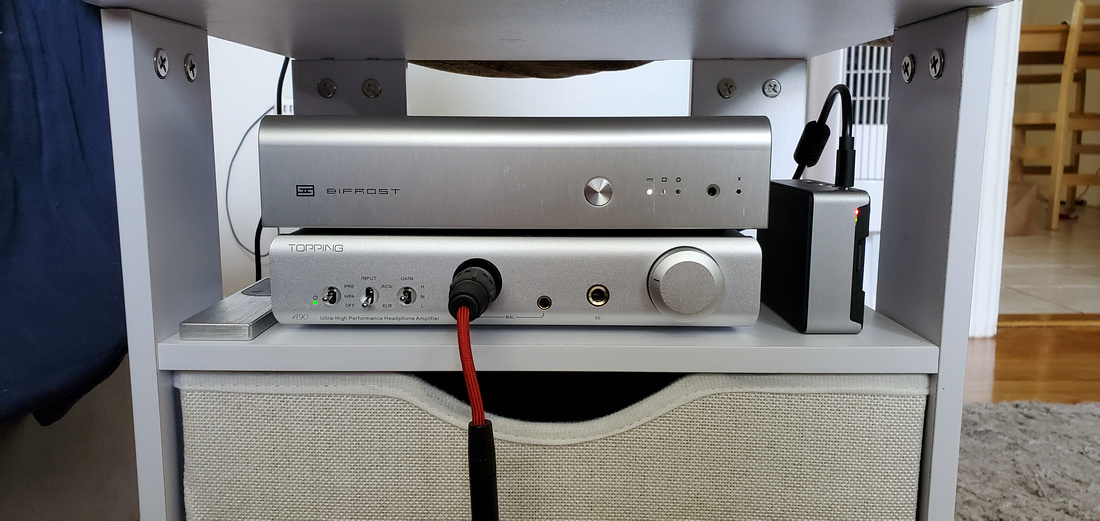 |
|
|
|
Post by chops on Apr 27, 2021 14:14:59 GMT -5
Already switched the DAC's back to their original spots.
Even though I had the M400 connected in the main system, I never gave it a listen since the headphone rig was the main concern at the time. Though the Topping A90/Schiit Bifrost 2 stack looks amazing, this combo did not sound amazing. Quite the opposite actually! A complete shocker to me!
With the Bifrost, bass got a little stronger, but also a bit muddled. Vocals, whether male or female, as well as any kind of midrange instruments took on an overbearing shouty, etchy trait. Treble wasn't too terribly bad except for the fact that it had a slight gritty sound to it. Not a pleasant experience, and not one that I was expecting at all from the Bifrost 2.
Back in the main system, the Bifrost 2 sounds excellent again with the sound that I love, and the sound that shines through the speakers and subs flawlessly.
No, I never listened to the M400 in the main system, so what I don't know won't hurt me. All I know is that the M400 sounds excellent in the headphone rig and the synergy with the A90 amp and my Sundara's are perfect.
|
|
|
|
Post by chops on May 21, 2021 23:00:15 GMT -5
|
|
|
|
Post by garbulky on May 22, 2021 11:47:57 GMT -5
Those Klipsch are looking bada$$ !! Bet you are enjoying the sound! |
|
|
|
Post by chops on May 22, 2021 12:33:28 GMT -5
Thank you! Yes, considering they don't sound like traditional Klipsch at all, which is a great thing! Still very dynamic with deep, tight bass, full, natural sounding midrange, and smooth, clean, refined treble. No boom, no honky midrange, no shrilly ear bleeding treble. Not to mention they image very well and produce a a tall, wide, "surrounding" sound stage. These are by far the best sounding Klipsch speakers I have heard to date, and that's including pretty much all of the Heritage line as well. They still have that lively, efficient attitude of horn speakers, yet the sound and refinement of normal, enclosed dynamic drivers. So far, no complaints at all. And to think these only cost $1200 for the pair. |
|

